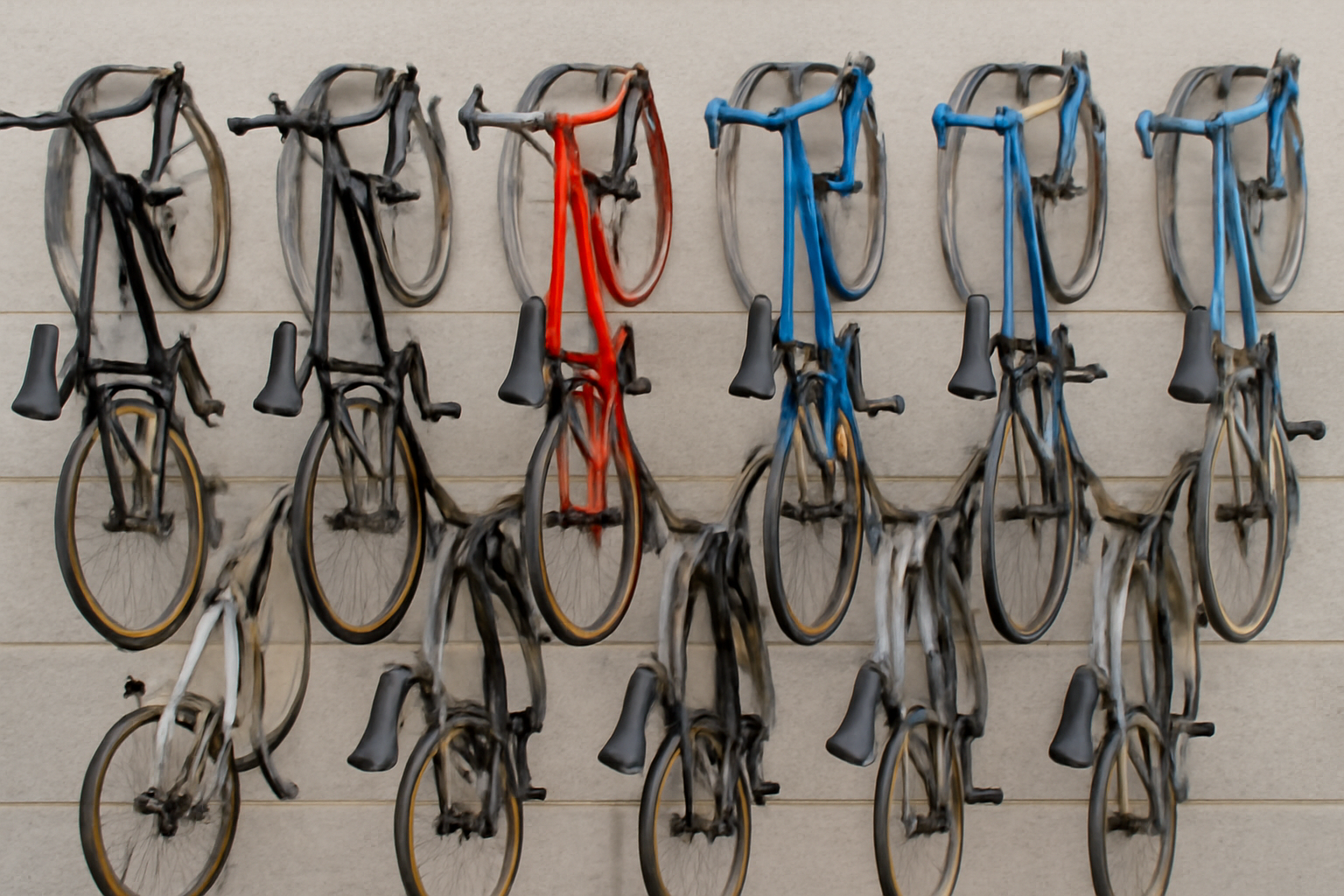If you are storing your bikes at home or transporting them on a car rack, they mustn’t bump into each other to avoid damage and make the most out of your space.
Knowing how to keep bikes from hitting each other on rack can salvage their condition, prevent scratches, and prolong the lifespan of the frames and components. Not only will a well-organised bike rack maximise storage, but it will also prevent your valued bikes from picking up excess wear and tear.
In this guide, we’ll be offering you handy tips on how to safely store your bikes on racks, both at home and on the road.
2. Understand the Types of Bike Racks
Understanding the various types of bike racks that exist is an important part of understanding how to make bikes not knock each other off when they are on the rack.
Choosing the ideal rack is a significant factor in preventing your bikes from being insecurely stored. The various types of racks vary in features that determine the position of the bikes and the space between the bikes.
By understanding the differences, you can make the correct selection that will avoid any accidental harm caused by bikes crashing into each other. The most common types of bike racks are mentioned below:
- Roof Racks
- Hitch Racks
- Trunk Racks
- Indoor Bike Storage Racks
2.1. Roof Racks
Roof racks offer a secure space for bikes but are challenging in the aspect of putting spacing in between. They are ideal for propping bikes off the ground and out of harm’s way.
However, based on the configuration of the rack, bicycles may be set too close together. Be careful to take pains to ensure that each bicycle is adequately tied up, with some space in between them so that scratches or dents do not happen during transportation. Take note of the weight capacity and structure of the rack so as not to overloading or tie up the bicycles improperly.
- Advantages: Convenient, easy to use, space-saving
- Disadvantages: Contact risk between bikes, needs adjustment for proper positioning
2.2. Hitch Racks
Hitch racks are a common mode of car bicycle transport, but can be susceptible to collision unless adjusted. They are mounted on the vehicle’s hitch and therefore convenient and easy to employ. The only limitation is that bicycles are positioned tightly together, which creates a greater contact risk.
To minimize this, ensure the rack is adjustable and provide tie-downs or frame protectors to secure bikes in place. Hitch racks also vary in design, so it might be possible to get one with sufficient space between bikes not to touch each other.
- Pros: Easy to load and unload, most suitable for long-distance journeys
- Cons: Risk of bikes touching or shifting during shipping
2.3. Trunk Racks
Trunk racks are inexpensive and convenient but expose the bikes to contact. Trunk racks attach to the back of your car and are usually easier to install than roof or hitch racks.
However, the bikes will be haphazardly stacked on the rack, bumping into one another along the way. To minimize this risk, use trunk racks with adjustable arms or separate bike slots that have more space between bikes.
In addition, using additional straps or tie-downs to secure bikes can prevent them from moving when being transported.
- Benefits: Low cost, easy to set up, good for short distances
- Drawbacks: Compact space, the bikes tend to collide when not properly secured
2.4. Indoor Bike Storage Racks
For domestic use, indoor racks provide systematic solutions, but absent careful placement, bikes can still end up touching. Indoor racks ensure your bikes are secure and ready to ride at a moment’s notice. They can be mounted on walls, stand on floors, or go up and down vertically, depending on your available space.
But careless placement or stacking of bikes can result in them touching, hence getting scratched or otherwise damaged. Racks with distinct bike spaces or adjustable spacing can guarantee that each bike is securely isolated while kept indoors.
- Strengths: Conserves space, keeps bikes organized
- Weaknesses: Needs to be well planned so as not to cause damage from contact
3. Stopping Bikes from Crashing into One Another on Racks
Regardless of the kind of rack, the following are some of the ways that you can store your bikes safely and spaced. Proper spacing and securing in a manner that will prevent bikes from getting scratched, dented, or otherwise damaged is crucial. With a few straightforward methods, you can prevent bikes from coming into contact with each other, whether in storage or transit. The following are some of the best practices:
- Utilize Bike Frame Protectors
- Choose Adjustable Racks with Individual Slots
- Invest in Tie-Downs and Bike Straps
- Utilize a Vertical Bike Rack for Indoor Storage
3.1. Utilize Bike Frame Protectors
The simple solution is to use frame protectors, which cushion the bikes and prevent them from scratching when they come into contact. Frame protectors are available in various materials, such as foam or rubber, and for various components of the bicycle, including the wheels, handlebars, and frame.
Frame protectors prevent direct damage by protecting the contact points. They also keep the bikes in position by absorbing any minimal movement that would cause them to knock against one another during storage or transportation.
- Benefits: Prevents dents and scratches, impact absorption
- Challenges: Needs to be applied to areas of high contact
3.2. Utilize Adjustable Racks with Individual Slots
Adjustable racks provide the option of changing the distance between each bike to prevent them from crashing into each other. The racks consist of slots or hooks that are adjustable based on the size of the bikes and the space needed between them.
The adjustable feature to move the space between bikes is especially handy if you are storing bikes of different sizes or carry more than a single bike. In this way, you can prevent them from touching one another and damaging each other.
- Pros: Adjustable, ideal for different bike sizes
- Cons: Time-consuming to set up, not all racks are adjustable
3.3. Buy Bike Straps and Tie-Downs
Bike straps are effective in holding bikes in place, preventing movement that can lead to accidental collision. Straps are designed to secure the bikes to the rack firmly, so they won’t shift during the journey. By holding each bike securely in place, you can avoid any accidental collision. Bike tie-downs also stabilize bikes on racks, especially during long journeys where movement is inevitable.
- Benefits: Secures bikes tightly, prevents movement
- Challenges: May need additional equipment for multiple bikes
3.4. Choose a Vertical Bike Rack for Home Storage
For indoor storage, a vertical bicycle stand can enable you to store bicycles at different heights so that they do not knock against one another. Such racks are designed to hold bikes upright in a vertical position, which reduces the amount of horizontal space taken up. Vertical stands also keep bikes separated from each other, with greater space between each bike.
Further, by holding bikes at different positions, you can even reduce the possibility of contact, safeguarding each bike from scratches or other damage.
- Advantages: Saves space, separates bicycles
- Disadvantages: May occupy more vertical space, not suitable for all bikes
4. Car Bike Rack Tips
Riding bikes on a car rack can be improved with additional safety measures to ensure bikes are safe and not damaged. Whether you use a roof, hitch, or trunk rack, the purpose is to secure bikes stably so that they won’t collide with each other on the way. Some of the tips on securing bikes securely without collisions are:
- Secure Bikes with Frame Mounting
- Consider the use of a bike rack with spacers
- Take off front wheels where possible
4.1. Frame mounting to secure bikes
Frame mounting racks support the bike at numerous points, stabilizing them and preventing movement on transport. Such racks support the bike at the frame, minimizing movement and preventing the possibility of bikes crashing into each other.
When using a rack that supports the bike at varied points, you can ensure that it stays firmly positioned, even on bumpy roads. This is one of the safest means of transporting bikes.
- Advantages: Holds bikes in place, prevents shifting
- Disadvantages: May include inherent rack compatibility
4.2. Consider Using a Bike Rack with Spacers
Some racks feature spacers that act as a cushion between bikes, preventing contact. The spacers are inserted between bikes to maintain distance, and there is an additional layer of protection. If your current rack does not have built-in spacers, you can often look for universal spacers that you can install on most bike racks.
- Benefits: Provides clearance, decreases risk of collision
- Challenges: Introduces an additional element to install
4.3. Remove Front Wheels When Possible
Removing the front wheels of your bicycles before loading them onto a rack will create space, reducing the likelihood of impact. Without the wheels, the bicycles take up less space on the rack, allowing bigger gap distance between them. This makes them fit on the rack more securely by reducing the bike’s overall width.
- Pros: Reduces space, does better in separation
- Challenges: Requires extra effort to remove and re-mount wheels
5. Common Mistakes to Avoid When Using Bike Racks
To effectively prevent bikes from knocking against each other, avoid these common mistakes when using your rack. Attention to detail and care both during transportation and assembly are paramount to ensuring your bikes are safe and secure. Some mistakes to watch out for include:
- Overloading the Rack
- Incorrectly Attaching Bikes
- Storing Bikes in Enclosed Spaces
5.1. Overloading the Rack
It is tempting to load as many bikes as can fit, but overloading can result in bikes bumping against one another. Going over the weight or space capacity of the rack will make bikes unstable and prone to collisions. Always verify the manufacturer’s suggested load capacity of the rack and do not surpass it to maintain bike separation.
- Mistake: Too much weight or bikes on the rack
- Solution: Follow load restrictions to prevent bikes from moving or coming into contact
5.2. Inadequate Securing of Bikes
Too few tie-downs or loose securing of the bikes will cause them to move during transportation or storage. Bikes that are not properly attached to the rack may move and cause them to knock into each other. Utilize multiple straps and tie each bike securely to minimize movement during travel.
- Mistake: Bikes not secured tightly enough
- Solution: Use multiple tie-downs to prevent movement
5.3. Storing Bikes in Tight Spaces
Tight spaces may seem convenient, but they increase the chances of bikes scraping or hitting each other. Whether you’re storing bikes on a rack at home or transporting them, cramming them into small spaces can cause unnecessary damage. Always leave enough room between bikes to avoid contact.
- Mistake: Too little space between bikes
- Solution: Ensure bikes have enough room to stay separate
Conclusion
By employing these easy-to-use techniques and choosing a proper rack, you can store your bicycles securely, safely, and scratch-free during storage or transport. With the employment of frame protectors, adjustable racks, or bike tie-downs, you can avoid most bike-to-bike collision and scratch/dent damage. It is wise to plan ahead and choose a rack appropriate to your specific needs, either for home storage or car transport. Your bikes will be maintained in ideal condition and prepared for the upcoming ride or excursion if proper care is taken.

I am Ryan Ford, a mountain biking enthusiast who loves to explore the outdoors. I also like to go on adventures with friends and anything else that involves being outside. I love my bike because it gets me out of the house and gives me an opportunity to enjoy nature.

